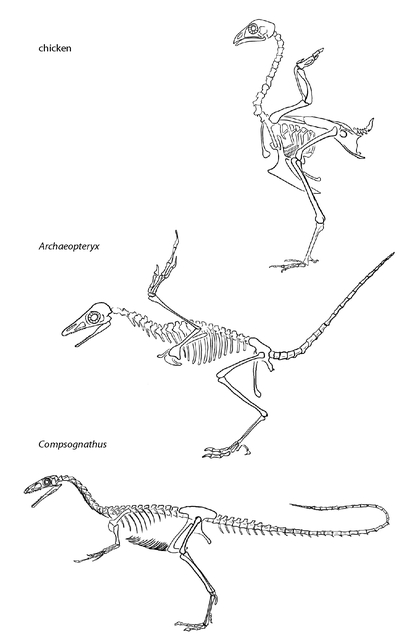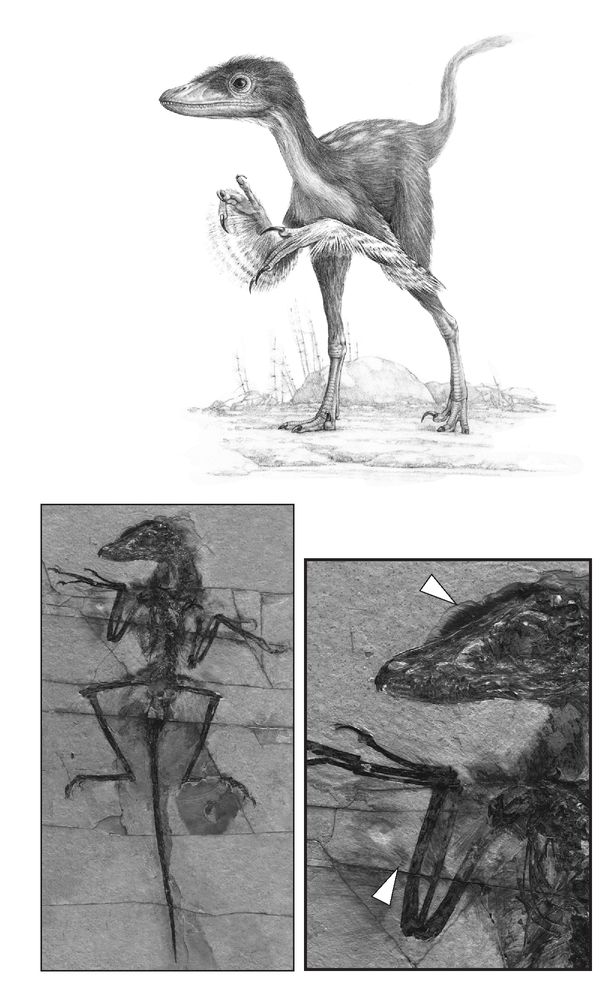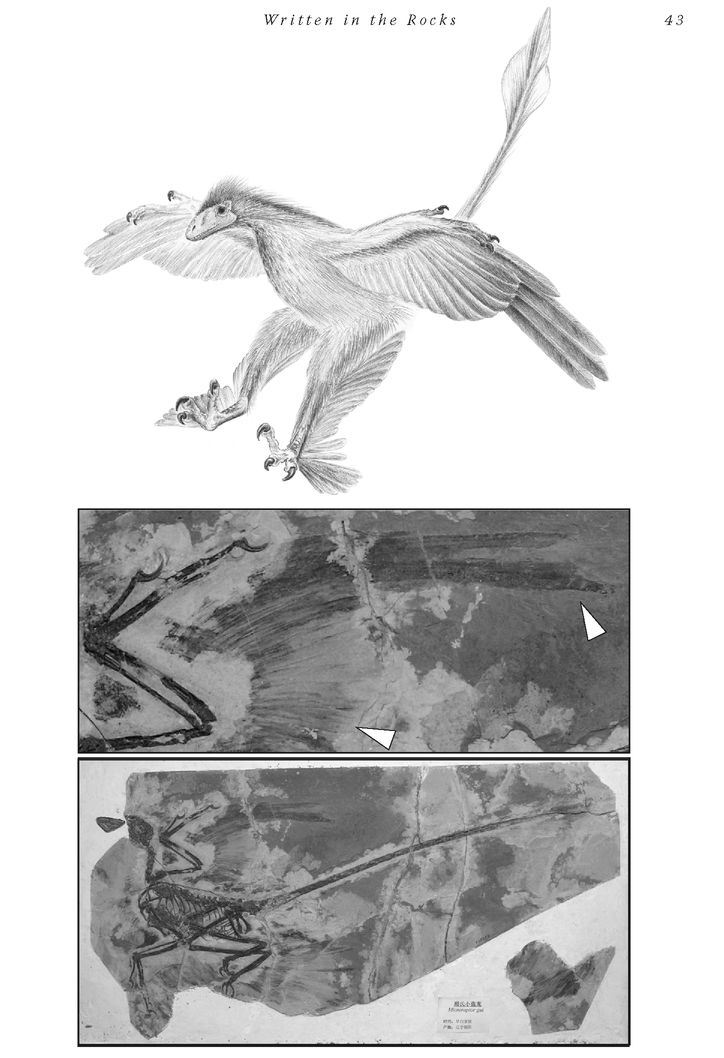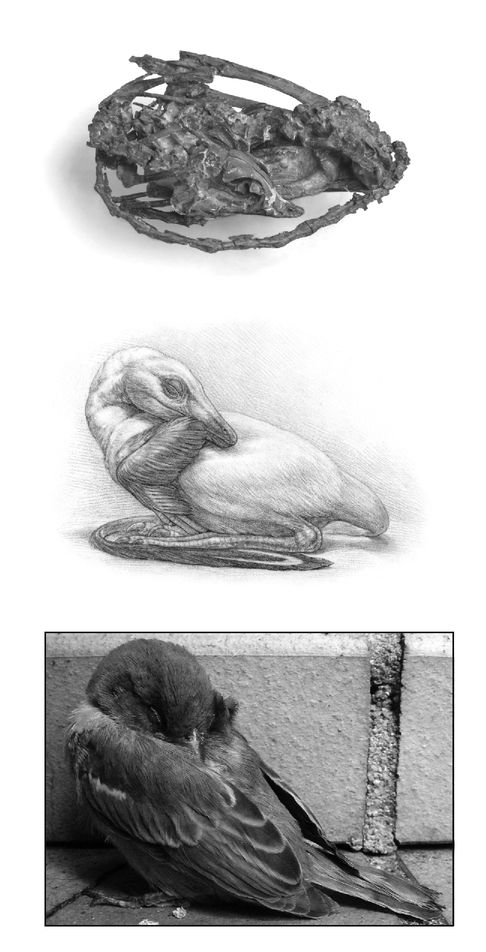Why Evolution Is True (9 page)
Read Why Evolution Is True Online
Authors: Jerry A. Coyne

But if you think a bit, it’s not so hard to come up with intermediate stages in the evolution of flight, stages that might have been useful to their possessors. Gliding is the obvious first step. And gliding has evolved independently many times: in placental mammals, marsupials, and even lizards. Flying squirrels do quite well by gliding with flaps of skin that extend along their sides—a good way to get from tree to tree to escape predators or find nuts. And there is the even more remarkable “flying lemur,” or colugo, of South-east Asia, which has an impressive membrane stretching from head to tail. One colugo was seen gliding for a distance of 450 feet-nearly the length of six tennis courts—while losing only forty feet in height! It’s not hard to envision the next evolutionary step: the flapping of colugolike limbs to produce true flight, as we see in bats. But we no longer have to only imagine this step: we now have the fossils that clearly show how flying birds evolved.
Since the nineteenth century, the similarity between the skeletons of birds and some dinosaurs led paleontologists to theorize that they had a common ancestor—in particular, the
theropods:
agile, carnivorous dinosaurs that walked on two legs. Around 200 million years ago, the fossil record shows plenty of theropods but nothing that looks even vaguely birdlike. By 70 million years ago, we see fossils of birds that look fairly modern. If evolution is true, then we should expect to see the reptile-bird transition in rocks between 70 and 200 million years old.
theropods:
agile, carnivorous dinosaurs that walked on two legs. Around 200 million years ago, the fossil record shows plenty of theropods but nothing that looks even vaguely birdlike. By 70 million years ago, we see fossils of birds that look fairly modern. If evolution is true, then we should expect to see the reptile-bird transition in rocks between 70 and 200 million years old.
And there they are. The first link between birds and reptiles was actually known to Darwin, who, curiously, mentioned it only briefly in later editions of
The Origin,
and then only as an oddity. It is perhaps the most famous of all transitional forms: the crow-sized
Archaeopteryx lithographica,
discovered in a limestone quarry in Germany in 1860. (The name
Archaeopteryx
means “ancient wing,” and “lithographica” comes from the Solnhofen limestone, fine-grained enough to make lithographic plates and preserve the impressions of soft feathers.) Archaeopteryx has just the combination of traits one would expect to find in a transitional form. And its age, about 145 million years, places it where we would expect.
The Origin,
and then only as an oddity. It is perhaps the most famous of all transitional forms: the crow-sized
Archaeopteryx lithographica,
discovered in a limestone quarry in Germany in 1860. (The name
Archaeopteryx
means “ancient wing,” and “lithographica” comes from the Solnhofen limestone, fine-grained enough to make lithographic plates and preserve the impressions of soft feathers.) Archaeopteryx has just the combination of traits one would expect to find in a transitional form. And its age, about 145 million years, places it where we would expect.
Archaeopteryx is really more reptile than bird. Its skeleton is almost identical to that of some theropod dinosaurs. In fact, some biologists who didn’t look at the
Archaeopteryx
fossils closely enough missed the feathers, and misclassified the beasts as theropods. (Figure 9 shows this similarity between the two types.) The reptilian features include a jaw with teeth, a long bony tail, claws, separate fingers on the wing (in modern birds these bones are fused, as you can see by inspecting a gnawed chicken wing), and a neck attached to its skull from behind (as in dinosaurs) instead of from below (as in modern birds). The birdlike traits number just two: large feathers and an opposable big toe, probably used for perching. It still isn’t clear whether this creature, though fully feathered, could fly. But its asymmetrical feathers-one side of each feather is larger than the other—suggest that it could. Asymmetrical feathers, like airplane wings, create the “airfoil” shape necessary for aerodynamic flight. But even if it could fly,
Archaeopteryx
is mainly dinosaurian. It is also what evolutionists call a “mosaic.” Rather than having every feature appear halfway between those of birds and reptiles,
Archaeopteryx
has a few bits that are very birdlike, while most bits are very reptilian.
Archaeopteryx
fossils closely enough missed the feathers, and misclassified the beasts as theropods. (Figure 9 shows this similarity between the two types.) The reptilian features include a jaw with teeth, a long bony tail, claws, separate fingers on the wing (in modern birds these bones are fused, as you can see by inspecting a gnawed chicken wing), and a neck attached to its skull from behind (as in dinosaurs) instead of from below (as in modern birds). The birdlike traits number just two: large feathers and an opposable big toe, probably used for perching. It still isn’t clear whether this creature, though fully feathered, could fly. But its asymmetrical feathers-one side of each feather is larger than the other—suggest that it could. Asymmetrical feathers, like airplane wings, create the “airfoil” shape necessary for aerodynamic flight. But even if it could fly,
Archaeopteryx
is mainly dinosaurian. It is also what evolutionists call a “mosaic.” Rather than having every feature appear halfway between those of birds and reptiles,
Archaeopteryx
has a few bits that are very birdlike, while most bits are very reptilian.
After the discovery of
Archaeopteryx,
no other reptile-bird intermediates were found for many years, leaving a gaping hole between modern birds and their ancestors. Then, in the mid-1990s, a spate of astonishing discoveries from China began to fill in the gap. These fossils, found in lake sediments that preserve the impressions of soft parts, represent a veritable parade of feathered theropod dinosaurs.
8
Some of them have very small filamentous structures covering the whole body—probably early feathers. One is the remarkable
Sinornithosaurus millenii (Sinornithosaurus
means “Chinese bird-lizard”), whose whole body was covered with long, thin feathers—feathers so small that they couldn’t possibly have helped it fly (figure 10a) And its claws, teeth, and long, bony tail clearly show that this creature was far from being a modern bird.
9
Other dinosaurs show medium-sized feathers on their heads and forelimbs. Still others have large feathers on the forelimbs and tail, much like modern birds. The most striking of all is
Microraptorgui,
the “four-winged dinosaur.” Unlike any modern bird, this bizarre, thirty-inch-long creature had fully feathered arms
and
legs (figure 10b), which when stretched out were probably used for gliding.
10
Archaeopteryx,
no other reptile-bird intermediates were found for many years, leaving a gaping hole between modern birds and their ancestors. Then, in the mid-1990s, a spate of astonishing discoveries from China began to fill in the gap. These fossils, found in lake sediments that preserve the impressions of soft parts, represent a veritable parade of feathered theropod dinosaurs.
8
Some of them have very small filamentous structures covering the whole body—probably early feathers. One is the remarkable
Sinornithosaurus millenii (Sinornithosaurus
means “Chinese bird-lizard”), whose whole body was covered with long, thin feathers—feathers so small that they couldn’t possibly have helped it fly (figure 10a) And its claws, teeth, and long, bony tail clearly show that this creature was far from being a modern bird.
9
Other dinosaurs show medium-sized feathers on their heads and forelimbs. Still others have large feathers on the forelimbs and tail, much like modern birds. The most striking of all is
Microraptorgui,
the “four-winged dinosaur.” Unlike any modern bird, this bizarre, thirty-inch-long creature had fully feathered arms
and
legs (figure 10b), which when stretched out were probably used for gliding.
10

FIGURE 9
. Skeletons of a modern bird (chicken), a transitional form (Archaeopteryx), and a small, bipedal, carnivorous theropod dinosaur (
Compsognathus
), similar to one of
Archaeopteryx’s
ancestors.
Archaeopteryx
has a few features like those of modern birds (feathers and an opposable big toe), but its skeleton is very similar to that of the dinosaur, including teeth, a reptilian pelvis, and a long bony tail.
Archaeopteryx
was about the size of a raven,
Compsognathus
slightly larger.
. Skeletons of a modern bird (chicken), a transitional form (Archaeopteryx), and a small, bipedal, carnivorous theropod dinosaur (
Compsognathus
), similar to one of
Archaeopteryx’s
ancestors.
Archaeopteryx
has a few features like those of modern birds (feathers and an opposable big toe), but its skeleton is very similar to that of the dinosaur, including teeth, a reptilian pelvis, and a long bony tail.
Archaeopteryx
was about the size of a raven,
Compsognathus
slightly larger.

FIGURE 10A
. The feathered dinosaur
Sinornithosaurus millenii,
original fossil from China (about 125 million years old), and artist’s reconstruction. The fossil clearly shows the impression of filamentous feathers, especially on the head and forelimbs (arrows).
. The feathered dinosaur
Sinornithosaurus millenii,
original fossil from China (about 125 million years old), and artist’s reconstruction. The fossil clearly shows the impression of filamentous feathers, especially on the head and forelimbs (arrows).

FIGURE 10B
. The bizarre “four-winged” dinosaur
Microraptor gui,
which had long feathers on both its fore- and hindlimbs. These feathers (arrows) are clearly visible in the fossil, about 120 million years old. It’s not clear whether this animal could fly or only glide, but the rear “wings” almost certainly helped it land, as shown in the drawing.
. The bizarre “four-winged” dinosaur
Microraptor gui,
which had long feathers on both its fore- and hindlimbs. These feathers (arrows) are clearly visible in the fossil, about 120 million years old. It’s not clear whether this animal could fly or only glide, but the rear “wings” almost certainly helped it land, as shown in the drawing.
Theropod dinosaurs didn’t just have primitive birdlike features, it seems: they even behaved in birdlike ways. The American paleontologist Mark Norell and his team described two fossils showing ancient behavior—and if ever fossils could be called “touching,” these are they. One is a small feathered dinosaur sleeping with its head tucked under its folded, winglike forearm—exactly as modern birds sleep (figure 11). The animal, given the scientific name
Mei long
(Chinese for “soundly sleeping dragon”), must have died while slumbering. The other fossil is a female theropod who met her end while sitting on her nest of eggs, showing brooding behavior similar to that of birds.
Mei long
(Chinese for “soundly sleeping dragon”), must have died while slumbering. The other fossil is a female theropod who met her end while sitting on her nest of eggs, showing brooding behavior similar to that of birds.
All the nonflying feathered dinosaur fossils date between 135 and 110 million years ago—later than the 145-million-year-old
Archaeopteryx.
That means that they could not be
Archaeopteryx’s
direct ancestors, but they could have been its cousins. Feathered dinosaurs probably continued to exist after one of their kin gave rise to birds. We should, then, be able to find even older feathered dinosaurs that were the ancestors of
Archaeopteryx.
The problem is that feathers are preserved only in special sediments—the fine-grained silt of quiet environments like lake beds or lagoons. And these conditions are very rare. But we can make another testable evolutionary prediction: someday we’ll find fossils of feathered dinosaurs that are older than
Archaeopteryx.
11
12
Archaeopteryx.
That means that they could not be
Archaeopteryx’s
direct ancestors, but they could have been its cousins. Feathered dinosaurs probably continued to exist after one of their kin gave rise to birds. We should, then, be able to find even older feathered dinosaurs that were the ancestors of
Archaeopteryx.
The problem is that feathers are preserved only in special sediments—the fine-grained silt of quiet environments like lake beds or lagoons. And these conditions are very rare. But we can make another testable evolutionary prediction: someday we’ll find fossils of feathered dinosaurs that are older than
Archaeopteryx.
11
12
We’re not sure whether
Archaeopteryx
is the one single species that gave rise to all modern birds. It seems unlikely that it was the “missing link.” But regardless, it’s one of a long string of fossils (some found by the intrepid Paul Sereno) that clearly document the appearance of modern birds. As these fossils get younger, we see the reptilian tail shrinking, the teeth disappearing, the claws fusing together, and the appearance of a large breastbone to anchor the flight muscles.
Archaeopteryx
is the one single species that gave rise to all modern birds. It seems unlikely that it was the “missing link.” But regardless, it’s one of a long string of fossils (some found by the intrepid Paul Sereno) that clearly document the appearance of modern birds. As these fossils get younger, we see the reptilian tail shrinking, the teeth disappearing, the claws fusing together, and the appearance of a large breastbone to anchor the flight muscles.

FIGURE 11
. Fossil behavior: the feathered theropod dinosaur
Mei long
(top) fossilized in a birdlike roosting position, sleeping with its head tucked under its forelimb. Middle: a reconstruction of
Mei
long from the fossil. Bottom: a modern bird (juvenile house sparrow) sleeping in the same position.
. Fossil behavior: the feathered theropod dinosaur
Mei long
(top) fossilized in a birdlike roosting position, sleeping with its head tucked under its forelimb. Middle: a reconstruction of
Mei
long from the fossil. Bottom: a modern bird (juvenile house sparrow) sleeping in the same position.
Put together, the fossils show that the basic skeletal plan of birds, and those essential feathers, evolved
before
birds could fly. There were many feathered dinosaurs, and their feathers are clearly related to those of modern birds. But if feathers didn’t arise as adaptations for flying, what on earth were they for? Again, we don’t know. They could have been used for ornamentation or display—perhaps to attract mates. It seems more likely, though, that they were used for insulation. Unlike modern reptiles, theropods may have been partially warm-blooded; and even if they weren’t, feathers would have helped maintain body temperature. And what feathers evolved
from
is even more mysterious. The best guess is that they derive from the same cells that give rise to reptilian scales, but not everyone agrees.
before
birds could fly. There were many feathered dinosaurs, and their feathers are clearly related to those of modern birds. But if feathers didn’t arise as adaptations for flying, what on earth were they for? Again, we don’t know. They could have been used for ornamentation or display—perhaps to attract mates. It seems more likely, though, that they were used for insulation. Unlike modern reptiles, theropods may have been partially warm-blooded; and even if they weren’t, feathers would have helped maintain body temperature. And what feathers evolved
from
is even more mysterious. The best guess is that they derive from the same cells that give rise to reptilian scales, but not everyone agrees.
Despite the unknowns, we can make some guesses about how natural selection fashioned modern birds. Early carnivorous dinosaurs evolved longer forelimbs and hands, which probably helped them grab and handle their prey. That kind of grabbing would favor the evolution of muscles that would quickly extend the front legs and pull them inward: exactly the motion used for the downward stroke in true flight. Then followed the feathery covering, probably for insulation. Given these innovations, there are at least two ways flight could then have evolved. The first is called the “trees down” scenario. There is evidence that some theropods lived at least partly in trees. Feathery forelimbs would help these reptiles glide from tree to tree, or from tree to ground, which would help them escape predators, find food more readily, or cushion their falls.
A different—and more likely-scenario is called the “ground up” theory, which sees flight evolving as an outgrowth of open-armed runs and leaps that feathered dinosaurs might have made to catch their prey. Longer wings could also have evolved as running aids. The chukar partridge, a game bird studied by Kenneth Dial at the University of Montana, represents a living example of this step. These partridges almost never fly, and flap their wings mainly to help them run uphill. The flapping gives them not only extra propulsion, but also more traction against the ground. Newborn chicks can run up 45-degree slopes, and adults can ascend 105-degree slopes—overhangs more than vertical!—solely by running and flapping their wings. The obvious advantage is that uphill scrambling helps these birds escape predators. The next step in evolving flight would be very short airborne hops, like those made by turkeys and quail fleeing from danger.
Other books
Martine The Beginning (Cruising to Love, The Prequel) by White, Edwina J
White Dog Fell From the Sky by Morse, Eleanor
Compulsively Mr. Darcy by Nina Benneton
Diana by Laura Marie Henion
13th Tale by 13th Tale
Till Human Voices Wake Us by Victoria Goddard
Take Me Home by Nancy Herkness
Torrent by David Meyer
The Sex MANual: Uncensored by Dean, Desiree
Fourth Down by Kirsten DeMuzio
